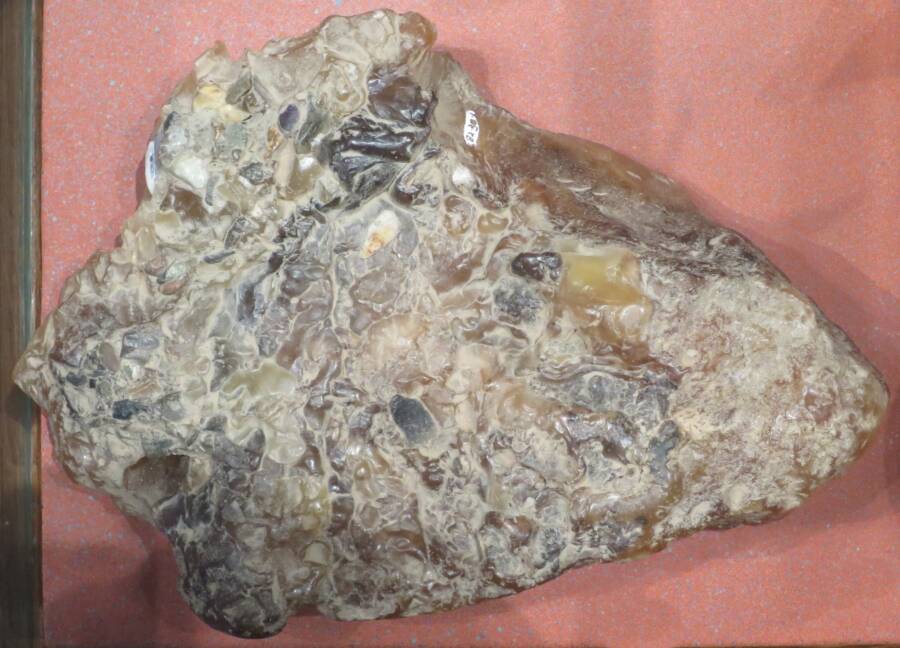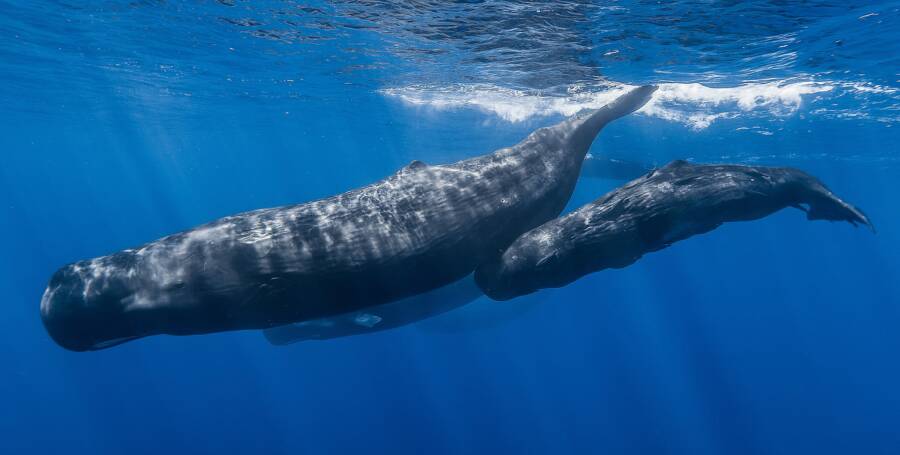Ambergris is a waxy substance sometimes found in the digestive system of a sperm whale — and it can be worth millions.
Perfumes famously employ ingredients like exotic flowers, delicate oils, and citrus fruits to produce a compelling scent. They also sometimes use a lesser-known ingredient called ambergris.
Though ambergris may conjure up images of something beautiful and soft, it’s something totally different. Commonly referred to as “whale vomit,” ambergris is an intestinal slurry that comes from the guts of sperm whales.
And, yes, it’s a highly coveted perfume ingredient. In fact, chunks of it can sell for thousands or even millions of dollars.
What Is Ambergris?

Wmpearl/Wikimedia CommonsA chunk of ambergris on display at Alaska’s Skagway Museum.
Long before ambergris reaches perfume bottles — or even fancy cocktails and delicacies — it can be found in its pure form within the guts of sperm whales. Why sperm whales? It all has to do with squids.
Sperm whales like to eat squids, but they can’t digest their sharp beaks. Though they usually vomit them up, the beaks sometimes make it into the whale’s gut. And that’s where ambergris comes into play.
As the beaks traverse the whale’s intestines, the whale starts to produce ambergris. Christopher Kemp, the author of Floating Gold: A Natural (and Unnatural) History of Ambergris described the likely process as such:
“As a growing mass, [the beaks] are pushed farther along the intestines and become a tangled indigestible solid, saturated with feces, which begins to obstruct the rectum… gradually the feces saturating the compacted mass of squid beaks becomes like cement, binding the slurry together permanently.”
Scientists aren’t exactly sure what happens at this point, though they think “whale vomit” is a misnomer for ambergris, since it’s likely a fecal matter as opposed to actual vomit. The whale might manage to pass the ambergris slurry and live to see another day (and probably eat more squid). Or, the obstruction might rupture the whale’s rectum, killing the creature.
Either way, scientists suspect that the production of ambergris is rare. It likely only happens in one percent of the world’s 350,000 sperm whales, and ambergris has only been found in five percent of sperm whale carcasses.
In any case, it’s what happens after the ambergris leaves the whale that interests the makers of fine perfumes around the world.
Fresh ambergris is black and has a stomach-churning odor. But as the waxy substance bobs through the sea and spends time under the sun, it begins to harden and lighten. Eventually, ambergris takes on a gray or even a yellowish color. And it also starts to smell much better.
Kemp described its smell as a “strange bouquet of old wood, and earth, and compost and dung, and wide open places.” In 1895, The New York Times wrote that it smelled “like the blending of new-mown hay, the damp woodsy fragrance of a fern-copse, and the faintest possible perfume of the violet.”
And Herman Melville, who wrote Moby Dick, described the scent emanating from a dead whale as “a faint stream of perfume.”
This strange, alluring smell — and properties that help a scent stick to human skin — has made ambergris a valuable substance. Chunks of it found on the beach have often fetched tens of thousands of dollars.
That’s one of the reasons why people have been scouring beaches for so-called “whale vomit” for hundreds of years.
Ambergris Throughout The Ages

Gabriel Barathieu/Wikimedia CommonsSperm whales are the only known creatures to produce ambergris.
Humans have been using ambergris for a variety of purposes for over 1,000 years. Early Arab civilizations called it anbar and used it as incense, an aphrodisiac, and even medicine. During the 14th century, wealthy citizens hung it around their necks to ward off the bubonic plague. And King Charles II of Britain was even known to eat it with his eggs.
People knew that ambergris had mysterious, coveted properties — but they weren’t sure what it was. In fact, the very name for ambergris comes from the French ambre gris, or gray amber. Yet people weren’t sure if ambergris was a precious stone, a fruit, or something else entirely.
They had some theories. Various people and civilizations have described ambergris as dragon spittle, the secretion of some unknown creature, remnants of underwater volcanoes, or even seabird droppings.
Ninth-century Muslim writers described it as a regurgitated substance — helping to establish the “whale vomit” myth — and a 15th-century encyclopedia of herbal medicines postulated that ambergris may have been tree sap, seafoam, or perhaps even a type of fungus.
But whatever ambergris was, it soon became clear to these people that it could be extremely valuable. Even Melville wrote in Moby Dick of the irony that “fine ladies and gentlemen should regale themselves with an essence found in the inglorious bowels of a sick whale.”
Indeed, “whale vomit” remains a highly coveted substance today. When a group of Yemeni fishermen stumbled upon a 280-pound chunk of the stuff in the belly of a dead whale in 2021, they sold it for $1.5 million.
How “Whale Vomit” Is Used Today

Ecomare/Wikimedia Commons Ambergris found in the North Sea.
Today, ambergris remains a luxury ingredient. It’s used in high-end perfumes and sometimes even in cocktails. (For example, there’s an ambergris drink in London called the “Moby Dick Sazerac.”)
But ambergris is not without significant controversy. Whalers often hunt sperm whales in search of “whale vomit” — as well as whale oil — which has decimated their populations. Today, there are laws to protect them.
In the United States, for example, ambergris is banned under the Marine Mammal Protection Act and the Endangered Species Act. But in the European Union, the Convention on International Trade in Endangered Species states that ambergris is something that is “naturally excreted” — and thus it can be bought and sold legally.
That said, there is a waning need for pure ambergris in most perfumes today. Synthetic versions of the so-called “whale vomit” began to emerge as early as the 1940s. That makes the need for scouring the beaches for amber rocks, or even killing sperm whales, less pressing for ambergris hunters.
Or does it? Some have argued that nothing can compare to pure ambergris. “The raw materials are absolutely magical,” said Mandy Aftel, a perfumer and an author who writes books on fragrances. “Its aroma affects everything else and that’s why people have pursued it for hundreds of years.”
So, the next time you spritz on a fancy perfume, just remember that its scent may have originated in the “inglorious bowels” of a sperm whale.
After learning about ambergris, read about the fisherman who was killed by a whale that he rescued. Then, check out the orcas that went on a killing spree in California.





